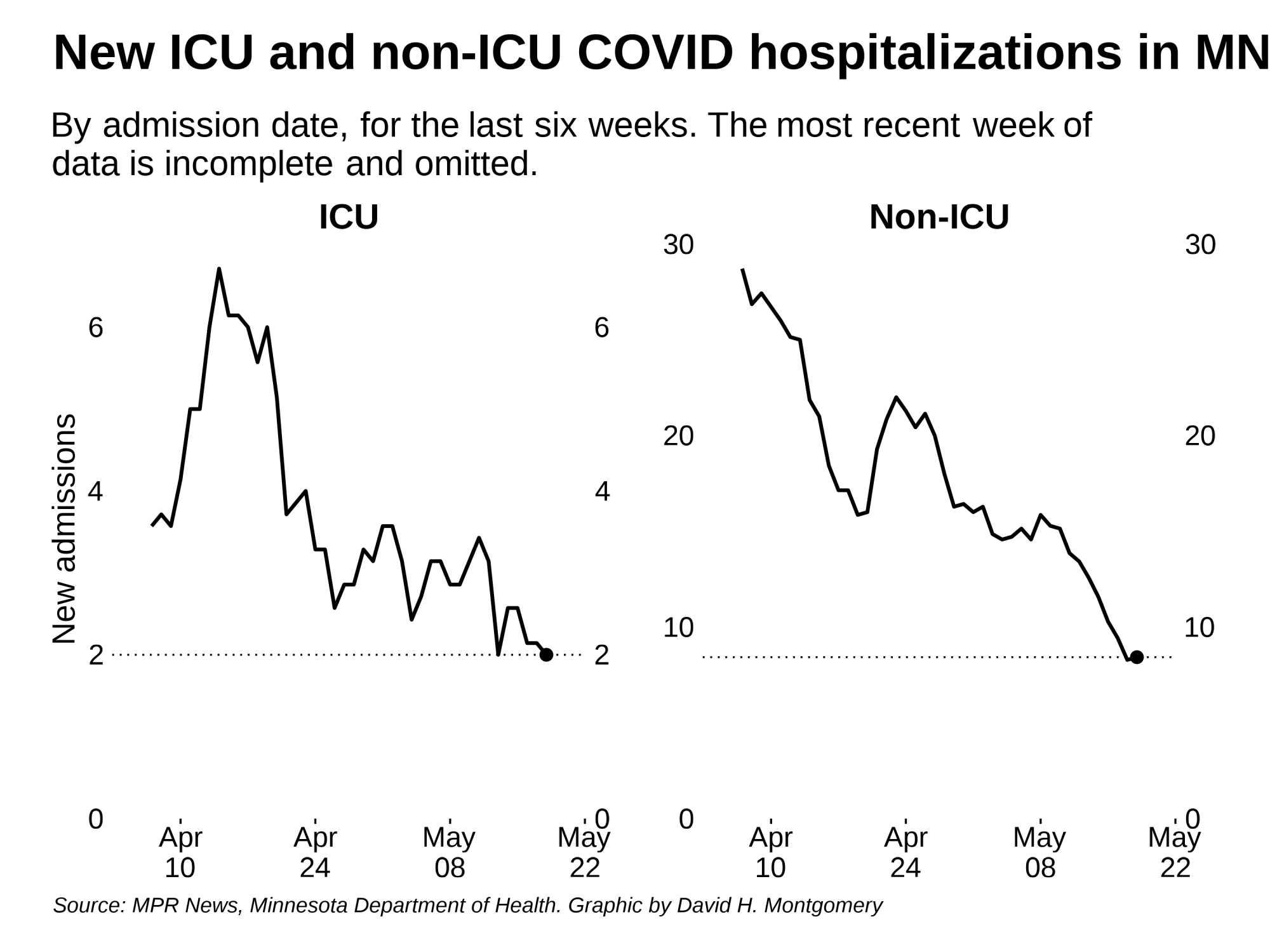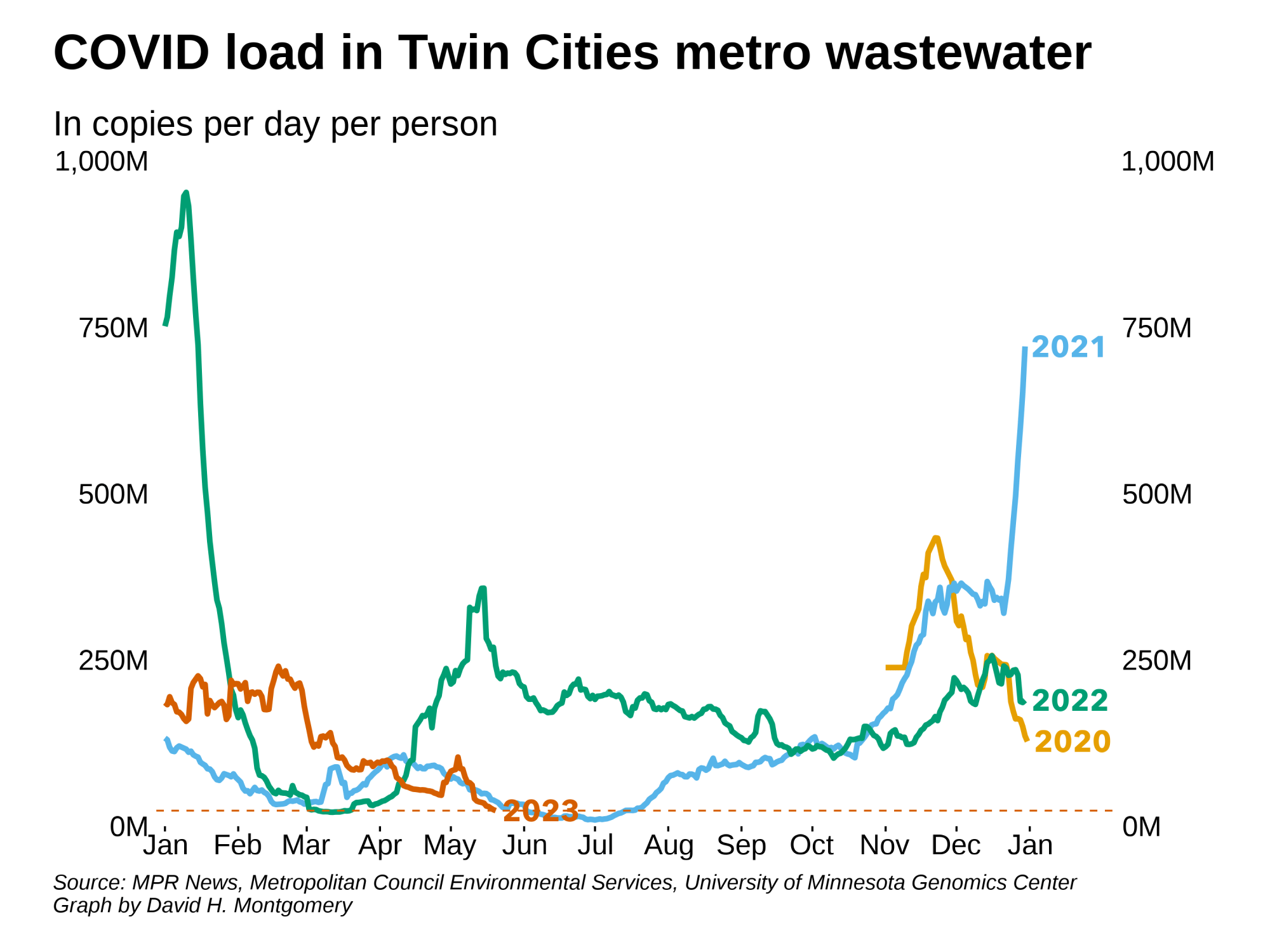'COVID emergency' over but concerns rise over loss of health insurance, mental health among younger Minnesotans

Go Deeper.
Create an account or log in to save stories.
Like this?
Thanks for liking this story! We have added it to a list of your favorite stories.
Updated: Tuesday 11:45 a.m.
The officially declared national public health emergency related to COVID-19 has now been over for two weeks. There were some risks associated with calling off the emergency — including the end to mandates for health insurers to reimburse for at-home COVID tests, changes to how vaccines are paid for and a loss of automatically continued Medicaid coverage for those who qualified during the pandemic.
The potential loss of health insurance is a particular concern. Here in Minnesota the Department of Human Services has mounted a campaign to keep those eligible for public health insurance enrolled and is publishing a dashboard to help track progress.
According to the dashboard, nearly 1.5 million Minnesotans are required to renew their state-sponsored health insurance over the next couple of years. So far, in April and May, about two percent of those up for renewal have lost coverage. If that rate continues over the next couple of years, approximately 30,000 Minnesotans could lose coverage. Some of these will undoubtedly gain employee-sponsored coverage, but the issue merits continued attention.
Among the other threats to the end of the public health emergency is the continued erosion of timely data. Here in Minnesota, we are still receiving relatively timely hospitalization and wastewater data, and so far, these trends continue to point in the direction of decreasing COVID threats. There are some notable exceptions.
Turn Up Your Support
MPR News helps you turn down the noise and build shared understanding. Turn up your support for this public resource and keep trusted journalism accessible to all.
Two weeks ago we shared that Minnesota’s rates of anxiety and depression remain elevated even while they are low relative to the nation as a whole. This week we dig deeper to show the alarmingly high rates among younger Minnesotans as well as those identifying as transgender.
COVID-19 Hospitalizations decline again
The daily average of COVID-19 admissions for the week ending May 18 reached a low not seen since the start of the pandemic: 10, including eight to regular hospital beds and two to intensive care units. This follows a several week-long trend of declining COVID-19 hospitalizations. (See the longer trend here.)

Health department data also shows that officially reported cases have dropped below 100 for the first time since the start of the pandemic – but official reports miss at-home tests as well as asymptomatic cases.
Over the most recent week for which the health department reports reliable COVID-19 mortality data, the week ending May 4th, there were an average of three COVID-19 deaths per day. While every death is a tragedy, this matches a low last seen in June 2022. Notably, the health department’s data shows a rare recent zero death-with-COVID day on April 28.
COVID levels in wastewater continue to be low and declining (with one possible exception)
The state’s most timely wastewater reporting, from the Metropolitan Council and the University of Minnesota’s Genomic Center, shows yet another decline in COVID-19 levels. For the week ending May 21, they are reporting “the total viral RNA [COVID-19] load entering the Metro Plant decreased by 36 percent last week compared to a week earlier. The load is now 90 percent lower than it was in mid-February and lower than it has been since mid-March 2022.”

The University of Minnesota’s parallel statewide wastewater analysis, which yesterday published finalized data through May 14, also shows low and continued decreasing COVID-19 levels in most of the state.
The big exception is in the study’s South East region, where COVID levels are up by nearly 600 percent over the past month. When questioned about this spike, a spokesperson for the University of Minnesota Wastewater Surveillance Team responded, “There was a large spike in one of the treatment plants, which has occurred before and is not unique to one particular site. The Wastewater Surveillance Team will monitor the next time point to determine if this is a trend or not. They have previously seen large spikes with an equally quick return to low levels.”
Indeed, the spike reflects elevated measurements on both May 7 and May 10, followed by a measurement more in the region’s normal range on May 14. And the Minnesota Department of Health’s county-by-county case and hospitalization reporting do not reflect any notable increases in COVID-19 activities in that region.
Anxiety and depression rates very high among transgender adults as well as young adults in both Minnesota and the U.S.
This week, U.S. Surgeon General Dr. Vivek Murthy issued an advisory warning about the mental health effects of social media, particularly among young people.
While social media can provide benefits, such as finding communities of support, being more connected with friends and serving as a creative outlet, there are risks as well. Children aged 12-15 who spent more than three hours per day on social media had double the risk of poor mental health, according to recent research cited by the surgeon general’s report. That amount of social media usage is not uncommon — in fact, the average for teenagers according to another recent study was 3.5 hours of social media usage per day.
Specific causes of mental health effects from social media use include perpetuating body dissatisfaction and amplifying social comparisons, especially among girls. Hate-based content is another cause.
The report follows another recent report related to mental health from the surgeon general, which focused on what he termed an epidemic of loneliness and isolation. That report mentions that while social media and technology can provide much-needed resources in some ways — such as online support groups — the harm comes from when it displaces in-person engagement, monopolizes our attention and reduces the quality of interactions.
Research has found, for example, that using phones during face-to-face interactions between parents and children, and between family and friends, led to more distraction, worse quality of conversation and less enjoyment of the time spent together.
So just how anxious and depressed are young people in the U.S., and Minnesota specifically? Our analysis of recent data from the U.S. Census Household Pulse Survey shows a solid of trend of increasing anxiety and depression as age decreases.
The data doesn’t include people under 18, who this week’s surgeon general’s report focused on, but for 18-24 year-olds, the numbers are striking. Transgender people in that age group had the highest rates of anxiety and depression among all of the age and gender groups, at 78 percent. Young women had the next highest, at 56 percent. Within each age group, women have higher rates of anxiety and depression than men, and transgender people reported much higher rates than women or men.
The same general trends hold true in Minnesota too, although the sample size of Minnesota transgender people was too small to include in our analysis. Women in the 18-24 age group had an anxiety or depression rate of 52 percent, which is more than eight times the group with the lowest rate — 6.4 percent for men aged 75 and up.
If you’re a parent or caregiver of children, the surgeon general’s report offers a few suggestions:
establish tech-free zones in your house to better foster in-person relationships
teach kids about responsible online behavior
model responsible online behavior
report problematic content and activity
For more, we’ve compiled a roundup of our recent mental health data coverage at the APM Research Lab.
Correction (May 30, 2023): This article has been updated to reflect the Minnesota Department of Human Services is responsible for public health enrollment efforts.


